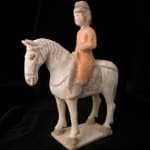Tang Polychrome Horse and Female Rider, 618 CE - 906 CE
Terracotta
height 31.8 cm
height 12 1/2 in
height 12 1/2 in
H.934
Further images
The great influence of the horse throughout the history of China cannot be underestimated. In fact, the ancient expansion of the Chinese Empire was due in large part to the...
The great influence of the horse throughout the history of China cannot be underestimated. In fact, the ancient expansion of the Chinese Empire was due in large part to the horse. The rapid mobility of horses allowed for quick communication between far away provinces. Likewise, the military role of horses aided in the defense of the borders from nomadic invaders as well as the conquest and submission of distant lands. In part, the need to import stronger, faster steeds from Central Asia (as opposed to the local Mongol pony) led to the creation of the legendary Silk Road. The importance of the horse in the history and culture of China can be viewed, in part, through the artistic legacy of this great civilization. In sculpture, painting, and literature, horses were glorified and revered. Furthermore, horses were believed to be relatives of the mythological dragon, reflecting their sacred status within society. They were prized for their rarity and became a status symbol for the aristocratic elite. Polo and other equestrian pastimes became popular. This sculpture, depicting an attendant riding on the back of a horse, reveals this connection between nobility and the horse. A striking amount of the original polychrome still remains intact, clearly visible in the white body of the horse and the black harnesses and numnah, as well as the attendant’s orange robe. We can imagine this attendant prancing around on this horse, perhaps taking part in an important ceremony. Discovered buried inside a tomb, this work was supposed to accompany the deceased throughout the afterlife. The striking beauty of this work is even more impressive, considering that it was created specifically for interment and was not supposed to be seen by the living. Today, we marvel in the beauty of this sculpture as much as its tremendous history and intriguing legacy.









